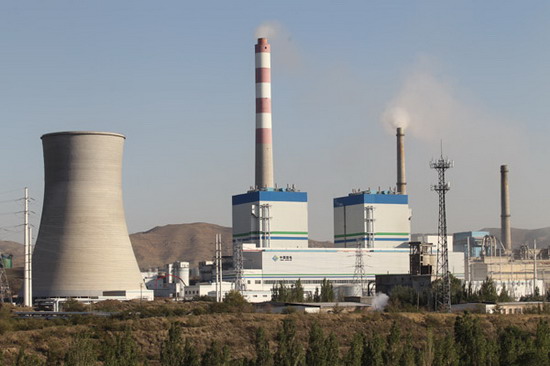Xinjiang's Energy
Xinjiang is an area rich in resources but lacking in infrastructure. But the Chinese government is directing it towards a more unified role in the energy sector, which means developing coal mining, processing, and transport. For foreign companies, the region show one of the last frontiers within the China market, and potentially one of the most beneficial.

In addition to the energy funneled through Xinjiang, China has been extracting the region for its own resources. "Xinjiang consist gas reserves of 1.4 trillion cubic meters, more than any other region or province", the official China Daily reported in February. Gas production from Xinjiang's Tarim Basin field calculated for more than a fifth of China's total output last year. In 2008, the region produced 27.4 million tons of oil (550,000 barrels per day), or over 14 percent of China's output, making it the country's second-biggest oil center. "Xinjiang also has 40 percent of China's coal reserves", the official Xinhua news agency reported.
Xinjiang's Trade
In 1988, border trade exports and imports over only US$36.0 million, accounting for 8.8 percent of the all foreign trade of the independent region. It was in the 1990s that the border trade really started to take off, climbing from US$94.4 million in 1991 to US$981.0 million in 2001. It calculated for more than half of the independent region's foreign trade for 10 successive years. The border trade has become a base and major growth area of Xinjiang's foreign trade and its economy as a whole.
Since 1986, the region has looked for ways to take advantage of its potential for growth when the central government gave approval to Xinjiang to conduct border trade. By 2002, its border trade was the second largest between the nine land border provinces, second only to Heilongjiang.
Xinjiang is a wide land with a low population aggregation, fewer industrial and mining companies within watered areas and comparatively little pollution which results in agricultural products meeting the provisions of being green or natural and protecting the environment. Many products can avoid devastation by plant disease and bugs. Almost closed geographical position, and so the dosage of farm chemicals can be decrease to the minimum. Statistics also show products with a “green food” sign are between the most popular in China.
Agricultural products in Xijiang are specific with powerful regional features, as they can't easily grow in other places. Even if those products grow elsewhere, their quality is mostly low compared with those from Xinjiang. It doesn't matter whether it is the white cotton and sugar, Chinese wolfberry, safflower, red tomato, carrot and chili, or different kinds of colorful fruits and melons, only those produced in Xinjiang are really great.
Agriculture in Xinjiang has been frequently mechanized and the operation is the major method of farming. Overhead applications of pesticides are carried out, while cotton and weeding reaping by machine also occurs. The ploughing, grading, sowing, application and collecting procedures of staple agricultural products like cotton, wheat and corn are largely mechanized, and people manage and do some ancillary work.
Machines facilitate cotton harvesting in Xinjiang
Xinjiang's Economy
Before the establish of the People’s Republic of China, the economy of Xinjiang was a natural economy, with farming and livestock reproduction as the mainstay. Industry was straggling and there were no railways or up-to-the-mark factories or mines. Hunger were repeated in some areas, and the people were impoverished. Xinjiang was peacefully opened on September 25, 1949. On October 1, 1955, the Xinjiang Uygur Autonomous Region was established, opening a new page for historic development in Xinjiang. In the past half century, Xinjiang’s economy and social undertakings have advanced by leaps and bounds.
Fast growth of the economy
Xinjiang’s foreign trade is navigated in multiple pliable ways, including spot trade, border trade, processing with materials supplied by clients, restitution trade, and tourism. By 2001, Xinjiang had trade relations with 119 countries and regions. Nearly 1,000 merchandise items in 22 categories were on the export list. Between them, 10 export commodities got more than US$ 10 million each. The total cost of Xinjiang’s exports and imports averaged to US$ 1.77 billion in that year. The export product mix has been permanently improved, from primary bulk products with low added cost to electromechanical and accuracy appliances with high added value. Now, manufactured goods account for 67% of Xinjiang’s exports.
Sources: http://www.academia.edu/413545/Private_Sector_Development_In_Xinjiang_China_
A_Comparison_Between_Uyghur_and_Han
Population in Xinjiang
Xinjiang is home to 19 million people, about 8 percent of China’s population. In 1949, about 15 percent of the people Xinjiang were Han Chinese, 75 percent were Uighurs and 10 percent were other. In 1949 Urumqi was only 20 percent Chinese, now it is 80 percent. Kazakhs made up roughly 9 percent of the population the 1940s and only 7 percent today.

Today Uighurs make up approximately 40 percent to 45 percent of the population of Xinjiang. Although their numbers have been watery in northern Xinjiang by Han Chinese settlers and are now more there the Uighurs are still the majority in southern Xinjiang. Han Chinese have grown from 9 percent of the population of Xinjiang in 1945 to 40 percent today.

Ethnic Groups"The Xinjiang Uyghur Autonomous Region is indwell by people of many ethnic groups. Since the founding of the PRC in 1949, an increasing number of people have moved to and from Xinjiang, making more leading the phenomenon of a multiethnic population living together." Especially since reform and opening-up in 1978, many citizens, guided by market forces, have mostly moved together and on their own will between Xinjiang's rural and urban areas, between its northern and southern areas, and between Xinjiang and other inland areas, for the goals of education, employment, business or job-seeking.
Source:
http://www.womenofchina.cn/html/womenofchina/report/1056401.htmhttp://www.china.org.cn/english/China/165014.htm












 RSS Feed
RSS Feed